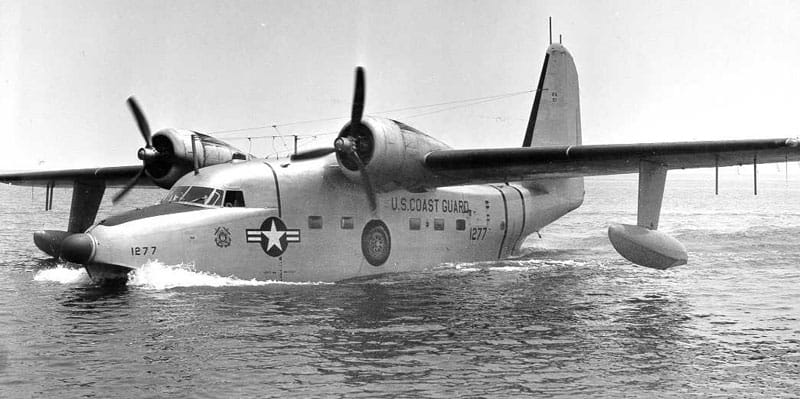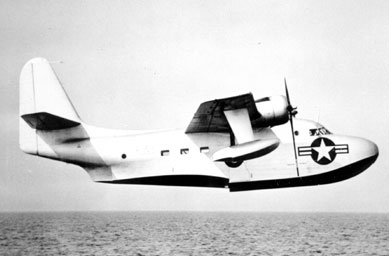
The Grumman Model G-64, the largest of a series of amphibians designed and manufactured by the Grumman Aircraft Corporation, was the only one originally developed for the military. Design work to meet the U.S. Navy requirement for an all-weather general purpose amphibious transport began in 1944. The Model G-64 was a continuation of the Model 21, JRF Goose design philosophy. It had a conventional two-step hull into which the main landing gear retracted; had a high wing; a single tail unit; and fixed stabilizing floats attached to the wings. The Model 64 structure, however, was refined to reduce drag; it had a cantilever tailplane; and tricycle landing gear. The Model 64 was larger and more powerful than the JRF; longer ranged and much more versatile. It was powered by two Wright 1820-76 engines rated at 1425 horsepower. The prototype, designated XJRF-1, flew on 24 October 1947.
Designated JR2F-1, the Navy had decided during development, that the initial order would be for an Anti-Submarine Warfare aircraft

configuration to be designated PF-1s. Meanwhile the aircraft had caught the attention of the newly created US Air Force (USAF). They were interested in using the aircraft as a search and rescue aircraft to replace the converted B-17s and B-29s presently in use. The initial Air Force procurement order was for 52 of these aircraft, designated as SA-16As, the first of which was delivered in July of 1949. Grumman delivered a total of 297 SA-16As to the USAF. Ironically the Air Force was the first service to receive a production aircraft, because the Navy had dropped its procurement of the aircraft as an ASW aircraft and instead ordered UF-1 Albatrosses to be used for utility aircraft.
Due in large part to correspondence initiated by Congressman Herbert Bonner, addressed to Treasury Secretary John W. Snyder, as to the state of Coast Guard aviation, funds became available for the purchase of the Grumman Albatross as a replacement for obsolescent Coast Guard SAR aircraft. Designated UF-1G, four were delivered in 1951; nine in 1952; nine in 1953; and an additional 14 in 1954. In addition, due to a change in Air Force rescue requirements, 15 Air Force SA-16As ordered from Grumman during 1952 were delivered to the Coast Guard as UF-1Gs with serial numbers 2121 to 2135. Beginning in December of 1953, 51 more SA-16s that had previously served in the Air Force were acquired. Coast Guard aircraft numbers were derived by assigning the last four digits of the Air Force serial number.
The Albatross proved to be ideal for the Coast Guard. It could operate from both land and water. For take-offs in open sea or short field operations it could be fitted with JATO affixed to each side of the aft fuselage. The external store racks fitted to each wing were used to carry 295 gallon drop tanks. When combined with the fuel capacity of the main tanks and fuel carried in the wing floats a range of over 2100 nautical miles and 14 plus hours in the air, with sufficient fuel reserve, was obtained, making it an excellent search vehicle. AN/APS-31A search radar was fitted in the nose. HF SSB receivers, interrogators, and MF/VHF/UHF direction finding equipment was standard. Sheltered water take-offs and landings at weights up to 32,000 pounds were possible without the use of JATO. Open sea operations were possible under favorable conditions with JATO. With lives at stake, however, there were numerous times when “possible” was substantially re-defined. There has been at least one recorded take-off without JATO in seven foot seas.
The aircraft were very mission adaptable and were located at air stations throughout the Continental United States as well as Alaska, Bermuda, Puerto Rico, Hawaii, Guam, and the Philippines. In addition to search and rescue the UF/HU-16 flew fishery patrols, pollution surveillance patrols, aids to navigation missions, logistic supply missions, law enforcement duties. A main cabin designed to carry ten passengers was equipped with a series of cargo tie down points which enabled the UF to be used to supply isolated duty stations throughout the Coast Guard. Up to 5000 pounds of cargo could be carried. Servicing at these locations was limited and the aircraft fuel system was such that gasoline could be put into the float tanks from 55 gallon drums and then transferred to the main tanks.
The one drawback of the UF-1G/SA-16A was unsatisfactory performance on one engine. Grumman engineers corrected the problem by adding a 70 inch wing section outboard of each engine and a 39 inch wing tip extension coupled with leading edge wing camber to replace the leading edge slots. Because of the increased wing area, the ailerons, fin, and stabilizers were increased in size. This modification resulted in a vast improvement in performance. Single engine operation at altitude was made possible. The modification also resulted in an increase in gross weight of 5000 pounds, an increase in cruise speed of 15 knots with no increase in fuel consumption and the stall speed was lowered to 64 knots. The Coast Guard UF-1G aircraft were converted to the UF-2G configuration. When the standardization of military air craft identification went into effect in 1962; the UF-2G became the HU-16E.

All of the UF-1G/SA-16A aircraft that were converted to UF-2G/SA-16B configuration had a series of holes drilled in the wing spar as part of the wing lengthening program. A test at the Navy research center at Patuxent River revealed that catastrophic failure along the holes might result. During 1966 the Coast Guard elected to participate in a full scale wing fatigue test. The object of the test was to determine whether major wing repair or replacement of the wing should be required. Tests resulted in a failure of the starboard wing. The Coast Guard chose not to replace the wing on the HU-16E and subsequent engineering calculations resulted in the establishment of an aircraft service life of 11,000 flight hours.
During the 32 years of service with the Coast Guard the Albatross came to be known by those that flew them as the “Goat.” It is not clear how the name originated but it was used as a term of affection. By the mid 1970s the active fleet of HU-16s had dwindled to 20, located at five air stations. These aircraft were retired as they approached the 11,000 flight hour limit. During October of 1977 HU-16E 7236 departed the Traverse City, Michigan air station on its last flight, to the U.S. Naval Air Museum at Pensacola Florida where it resides today. On 10 March 1983 the last operational HU-16E, Coast Guard number 7250, made its final flight. In the intervening years these aircraft flew well over 500,000 hours and a countless number of people owe their lives to them and the crews that flew them.
| Manufacturer | Grumman Aircraft Corporation | Top Speed | 210 kts |
| Designation | UF-2G | Cruise Speed | 140 kts |
| Other Designation | HU-16E – SA16B | Range | 2300 nautical miles |
| Aircraft Type | Amphibian | Empty Weight | 22,880 lbs |
| Wing Span | 96’ 8” | Gross Weight | 35,700 lbs |
| Height | 25’ 10” | Service ceiling | 23,500 ft |
| Length | 62’ 10” | Engines | 2 Wright R-1820-76B |
| Fuel Capacity | 1666 gal – with full aux tanks | Propeller | HS Hydromatic 600 1A-7 |

World Class Amphibian Records
The Grumman Albatross is the holder of nine world class amphibian records certified by the Federation Aeronautique International, the world’s governing body for aviation records. The records were established as a result of a tri-service venture by the US Coast Guard, US Navy and US Air Force. The records were established using Coast Guard HU-16E 7255 as follows:
- Speed over a 1,000 km closed course with a 1,000 kg load: Established by CDR Wallace C. Dahlgren, USCG and CDR William G. Fenlon, USCG on 13 August 1962 at a speed of 201.5 knots.
- Speed over a 1,000 km closed course with a 2,000 kg load: Established by CDR Wallace C. Dahlgren, USCG and CDR William G. Fenlon, USCG on 13 August 1962 at a speed of 201.5 knots.
- Speed over a 5,000 km closed course with a 1,000 kg load: Established on 15 and 16 September 1962 by LCDR Hoffman USN, flying Coast Guard HU-16E 7255 at a speed of 131.5 knots.
- Altitude with a 1,000 kg load: Established on 12 September 1962 by LCDR Moore, USN, flying Coast Guard HU-16E 7255 at the altitude 29, 475 feet.
- Altitude with a 2000 kg load: Established on 12 September 1962 by LCDR Franke, USN, flying Coast Guard HU16E 7255 at altitude 27,405 feet.
- Distance–non-stop: Established on 24 October 1962 on a flight from USCG AIRSTA Kodiak to the US Naval Air Station at Pensacola, a distance of 3,104 miles, by CDR William G. Fenlon, USCG, CDR Wallace G. Dahlgren, USCG, LT W. Senn, USCG, and CPO W. Taggart, USCG.
Unless interest in amphibian aircraft development is renewed these records may never be exceeded.
